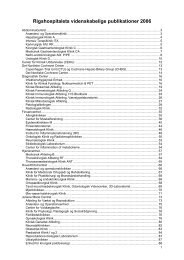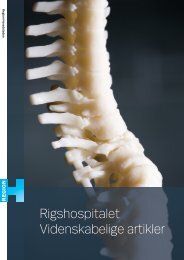View - CTU
View - CTU
View - CTU
Create successful ePaper yourself
Turn your PDF publications into a flip-book with our unique Google optimized e-Paper software.
tic treatments in DK<br />
Endodontic treatments in DK<br />
8j¢rndal & Reit<br />
'· Petersen et al.<br />
adults reported<br />
ientist and that<br />
rough the past<br />
e, Danish adults<br />
health services<br />
1ajor part of the<br />
about 40% of<br />
1ent. Hence, the<br />
h to believe that<br />
l reported.<br />
:t the hypothesis<br />
Nill decrease in a<br />
gression. Among<br />
.ls were filled in<br />
ldition can partly<br />
' patient populaber<br />
of root canals<br />
se reached 17%.<br />
Jlained by (i) the<br />
which has put<br />
f being pulpally<br />
nt of multi-rooted<br />
i1 ratio increased<br />
1d was also found<br />
llically examined<br />
the later sample<br />
more often than<br />
,-1975) and had<br />
tiled tooth group<br />
·al health among<br />
place at the end of<br />
'oulsen & Scheutz<br />
'anish 20-year-old<br />
•rted a very low<br />
nd concluded that<br />
to children had a<br />
mtal health status<br />
ndodontic point of<br />
;how a somewhat<br />
seems to be an<br />
rovided. Although<br />
with middle-aged<br />
common among<br />
(Tables 2 and 3).<br />
statistically signin<br />
the total Danish<br />
DNHI), the numfillings<br />
decreased<br />
irs of age, and<br />
Age groups 1998 1999 2000 2001 2002 2003<br />
20-29 102 110 103 113 114 116<br />
30-39 143 145 135 141 142 144<br />
40-49 156 154 144 150 150 151<br />
50-59 156 151 141 143 145 146<br />
60-69 139 132 124 127 125 123<br />
70-79 113 106 102 106 103 101<br />
80+ 96 88 85 83 84 81<br />
Age groups 1996 1997 1998 1999 2000 2001 2002 2003<br />
20-29 70 71 67 71 65 69 68 68<br />
30-39 102 104 103 103 94 96 95 95<br />
40-49 117 118 119 117 108 111 110 110<br />
50-59 113 114 119 116 109 110 110 111<br />
60-69 81 82 89 87 84 87 88 89<br />
70-79 50 51 55 53 52 56 54 57<br />
80+ 25 25 29 28 28 28 29 29<br />
Age groups 1996 1997 1998 1999 2000 2001 2002 2003<br />
20-29 60 60 57 58 56 56 54 51<br />
30-39 55 55 55 53 51 52 50 49<br />
40-49 85 85 83 81 78 78 76 73<br />
50-59 125 125 123 122 116 113 113 112<br />
60-69 138 138 139 138 133 134 130 130<br />
70-79 110 111 119 118 117 120 119 124<br />
80+ 82 80 88 85 85 86 90 89<br />
14<br />
2<br />
-+-Pulpotomies<br />
--Direct pulp cappings<br />
-.-stepwise excavation<br />
1976 1984 1992 2000<br />
Figure 3 The number of pulpotomies, direct pulp cappings<br />
and stepwise excavations per 1000 patients as reported by the<br />
DNHI. The number of pulpotomies is estimated up to 1987.<br />
Data on number of patients are based on estimates (1977-<br />
1987) and actual figures reported (1988-2003).<br />
increased among those above (Table 3). Similar<br />
changes were earlier described by Sundberg & Owall<br />
(1989), who between 1974 and 1985 found a 51 %<br />
p ± 2 SD<br />
P-value<br />
2.6 ± 0.8 0.038<br />
0.1±1.8 0.955<br />
-0.9 ± 2.0 0.429<br />
-1.9 ± 2.2 0.175<br />
-2.8 ± 1.6 0.029<br />
-1.9 ± 1.4 0.057<br />
-2.5 ± 1.3 0.018<br />
p ± 2 SD<br />
P-value<br />
-0.2 ± 0.7 0.423<br />
-1.5±0.8 0.001<br />
-1.5 ± 0.8 0.011<br />
-0.8 ± 1.0 0.144<br />
0.9 ± 0.7 0.046<br />
0.8 ± 0.2 0.001<br />
0.6 ± 0.3 0.016<br />
Table 2 The number of root fillings per<br />
1000 patients (actual users) in relation<br />
to age. P denotes the slope of the line of<br />
regression, representing an estimate of<br />
growth per year<br />
Table 3 The number of root fillings per<br />
1000 potential users in relation to age.<br />
P denotes the slope of the line of regression,<br />
representing an estimate of growth<br />
per year<br />
Table 4 The number of tooth extractions<br />
per 1000 potential users in relation<br />
p ± 2 SD P-value<br />
-1.1±0.3 0.000 to age<br />
-0.9 ± 0.2 0.000<br />
-1.7 ± 0.3 0.000<br />
-2.3 ± 0.5 0.000<br />
-1.4 ± 0.5 0.001<br />
1.7 ± 0.7 0.004<br />
1.1±0.7 0.013<br />
decrease in endodontic treatment among younger<br />
Swedish patients (20-29 years) and a 21 % increase<br />
among patients older than 70 years. In the Danish<br />
population the observations might partly be explained<br />
by recent changes in the dental visiting habits of<br />
adults. In an interview study, Petersen et al. (2003)<br />
reported that in 1987, 35% of the participants at<br />
ages 6 5-7 4 years saw a dentist regularly compared<br />
with 66% in 2000. A decrease of patients regularly<br />
attending the dental service was found among young<br />
adults. In 198 7, 90% of individuals at ages 2 5-34<br />
reported to visit a dentist on a regular basis and 78%<br />
in 2000. In addition, studying the aetiology of<br />
endodontic treatment in a Swedish county, Reit et al.<br />
(1993) found that about one-third of the treatments<br />
performed on patients over 60 years of age were not<br />
directly aimed to cure pulpal or periapical pathosis.<br />
Frequently, root canal treatments were carried out<br />
for prosthodontic reasons.<br />
During the period of the study, the number of<br />
pulpotomies performed was drastically reduced. This<br />
urnal, 37, 782-788, 2004<br />
International Endodontic Journal, 37, 782-788, 2004<br />
© 2004 International Endodontic Journal








